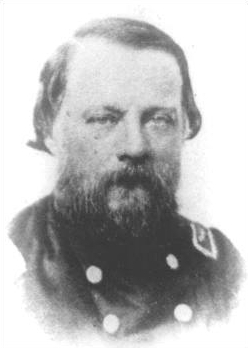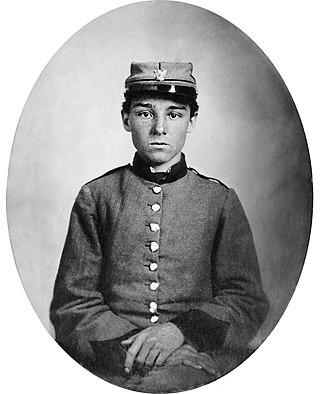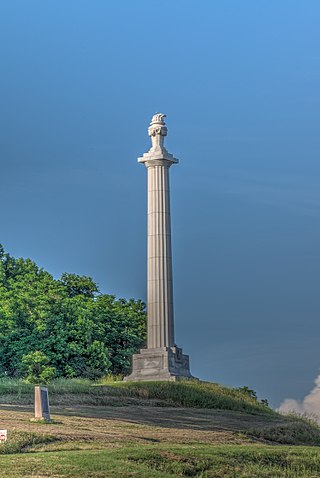
The 2nd Louisiana Cavalry Regiment was a unit of mounted volunteers recruited in Louisiana that fought in the Confederate States Army during the American Civil War. Breazeale's Cavalry Battalion was formed in July 1862 and was augmented by five additional companies in September 1862 to form a regiment. It served for the entire war west of the Mississippi River in the Trans-Mississippi Department. The regiment fought at Georgia Landing, Fort Bisland, Irish Bend, and Brashear City in 1863 and Henderson's Hill and Mansfield in 1864. Afterward, the regiment fought in minor skirmishes before the Trans-Mississippi's final surrender on 26 May 1865.

The 1st Louisiana Infantry Regiment was a unit of volunteers recruited in Louisiana that fought in the Confederate States Army during the American Civil War. Formed in April 1861, the regiment was sent to fight in the Eastern Theater of the American Civil War. Joining a brigade of Louisiana regiments, it fought at Malvern Hill, Second Bull Run, Antietam, and Fredericksburg in 1862, at Chancellorsville, Second Winchester, Gettysburg, and Mine Run in 1863, and at the Wilderness, Spotsylvania, Monocacy, Third Winchester, Fisher's Hill, Cedar Creek, and Petersburg in 1864, and at Appomattox in 1865. At Appomattox, the regiment was only a shadow of its former self.

The 2nd Louisiana Infantry Regiment was a unit of volunteers recruited in Louisiana that fought in the Confederate States Army during the American Civil War. Formed in May 1861, the regiment was sent to fight in the Eastern Theater of the American Civil War. Its first action took place during the Siege of Yorktown. The regiment suffered very heavy losses at Malvern Hill. After joining an all-Louisiana brigade, it fought at Cedar Mountain, Second Bull Run, Antietam, and Fredericksburg in 1862, at Chancellorsville, Second Winchester, Gettysburg, and Mine Run in 1863, and at the Wilderness, Spotsylvania, Cold Harbor, Monocacy, Third Winchester, Fisher's Hill, Cedar Creek, and Petersburg in 1864, and at Appomattox in 1865. The regiment lost over 100 men at both Second Bull Run and Chancellorsville. A company-sized remnant surrendered at Appomattox.

The Louisiana Guard Battery was an artillery unit recruited from volunteers in Louisiana that fought in the Confederate States Army during the American Civil War. Formed from an infantry company sent to fight in the Eastern Theater of the American Civil War, it was converted to an artillery company in July 1861. The battery fought at Cedar Mountain, Second Bull Run, Antietam, and Fredericksburg in 1862, and at Chancellorsville, Second Winchester, and Gettysburg in 1863. Most of the soldiers and all of the battery's guns were captured at Rappahannock Station on 7 November 1863. The surviving gunners manned heavy artillery pieces in the defenses of Richmond, Virginia, and the battery's remnant surrendered at Appomattox.

The 12th Louisiana Infantry Regiment was a unit of volunteers recruited in Louisiana that fought in the Confederate States Army during the American Civil War. Formed in August 1861, the regiment served in the Western Theater of the American Civil War and was unique in that there were 12 companies. The regiment garrisoned Island Number Ten before being stationed at Fort Pillow. It fought at Second Corinth in 1862 and Champion Hill and Jackson in 1863. A detachment served during the Siege of Vicksburg and was captured. In 1864, the regiment fought in the Meridian, Atlanta, and Franklin–Nashville campaigns, suffering heavy losses at Peachtree Creek and Franklin. It fought at Bentonville in 1865 before surrendering with General Joseph E. Johnston.

The 8th Louisiana Infantry Regiment was a unit of volunteers recruited in Louisiana that fought in the Confederate States Army during the American Civil War. Formed in June 1861, the regiment was sent to fight in the Eastern Theater of the American Civil War. Joining a brigade of Louisiana regiments, it fought in Jackson's Valley campaign and at Gaines' Mill, Malvern Hill, Second Bull Run, Antietam, and Fredericksburg in 1862. The regiment served at Chancellorsville, Second Winchester, Gettysburg in 1863. At Rappahannock Station in November 1863, most of the regiment was captured. The unit fought at the Wilderness, Spotsylvania, Cold Harbor, and the Valley campaigns of 1864. It served at Petersburg starting in December 1864 and surrendered at Appomattox in April 1865.

The Donaldsonville Louisiana Artillery was a Louisiana artillery unit that fought in the Confederate States Army during the American Civil War. Formed from an old militia company, it arrived in the Eastern Theater of the American Civil War in September 1861 with three obsolete guns and was equipped with three additional rifled guns. The battery fought at Yorktown, Williamsburg, Seven Pines, Gaines' Mill, Glendale, Second Bull Run, Antietam, Shepherdstown and Fredericksburg in 1862. The following year the unit served at Gettysburg and in the Bristoe and Mine Run campaigns. The battery fought in the Overland campaign and at the Siege of Petersburg in 1864. It surrendered at Appomattox in April 1865.

The 17th Louisiana Infantry Regiment was a unit of volunteers recruited in Louisiana that fought in the Confederate States Army during the American Civil War. The regiment formed at Camp Moore in September 1861 and served during the war in the Western Theater of the American Civil War. The unit stayed in New Orleans until February 1862 and then moved north to Corinth, Mississippi. The regiment first saw action at Shiloh in April 1862 while serving in Patton Anderson's brigade. Afterwards, the regiment redeployed to the Vicksburg area and repelled Sherman's attack at Chickasaw Bayou that December. In 1863 the regiment took part in the Vicksburg campaign, first fighting at Port Gibson and then at the Siege of Vicksburg in William Baldwin's brigade. On July 4, 1863, the regiment was surrendered along with all other Confederate soldiers at Vicksburg. The soldiers were paroled and went home. The regiment reported to a parole camp at Shreveport, Louisiana, in January 1864. The regiment was on garrison duty in western Louisiana for the remainder of the war, before disbanding in May 1865.

The 18th Louisiana Infantry Regiment was a unit of volunteers recruited in Louisiana that fought in the Confederate States Army during the American Civil War. The regiment began forming in October 1861, but did not reach its full complement of 10 companies until January 1862. It served throughout the war in the Western Theater of the American Civil War. In 1862, the regiment served at Shiloh, First Corinth and Georgia Landing (Labadieville). In 1863, it fought at Fort Bisland and campaigned in south Louisiana. In November 1863, the unit merged with the 10th Louisiana Infantry Battalion, creating the 18th Consolidated Louisiana Infantry Regiment. The new regiment served during the Red River campaign in 1864, fighting at Mansfield, Pleasant Hill, and Yellow Bayou. The regiment remained in Louisiana and Arkansas for the rest of the war, before disbanding in May 1865.

The 22nd Louisiana Infantry Regiment was a unit of volunteers recruited in Louisiana that fought in the Confederate States Army during the American Civil War. The regiment formed in April 1862 at New Orleans and served during the war in the Western Theater of the American Civil War. The men trained as gunners for heavy artillery and the regiment was split up to garrison various forts. Two companies were assigned to hold Fort Jackson, fought in the Defense of Fort Jackson, and surrendered afterward. One company made a futile defense during the Capture of New Orleans. The regiment reorganized at Camp Moore and traveled to Vicksburg, Mississippi, to participate in its defense. The unit was renamed the 21st Louisiana Infantry Regiment in January 1863. Elements of the regiment assisted in the repulse of the Yazoo Pass expedition. The soldiers served at the Siege of Vicksburg, surrendered when the city fell, and afterward reported to a parole camp. In January 1864, the 22nd Consolidated Louisiana Infantry Regiment was reconstituted with 780 men from seven different Louisiana units that had surrendered at Vicksburg. The unit was ordered to Mobile, Alabama, where four companies fought at Spanish Fort in March and April 1865. The regiment surrendered in May 1865.

The 23rd Louisiana Infantry Regiment was a unit of volunteers recruited in Louisiana that fought in the Confederate States Army during the American Civil War. The regiment organized in January 1862 at New Orleans by merging the Orleans Artillery Battalion, a state militia unit, with six independent companies. In March 1862, the unit mustered into Confederate service with 841 men and served during the war in the Western Theater of the American Civil War. The various companies were allocated to defend various forts. One company was assigned to hold Fort Jackson, fought in the Battle of Forts Jackson and St. Philip, and surrendered when the fort fell. After the Capture of New Orleans most of the companies disbanded. However, four companies reorganized at Camp Moore in May 1862 and traveled to Vicksburg, Mississippi where they manned the river batteries. In early 1863, the regiment was renamed the 22nd Louisiana Infantry Regiment. The soldiers went to Fort Pemberton where they helped drive off the Yazoo Pass expedition. The regiment was part of the garrison during the Siege of Vicksburg and was captured and paroled when the city fell in July 1863. The men reported to a parole camp. In January 1864, it and the remnants of six other Louisiana regiments were absorbed into the 22nd Consolidated Louisiana Infantry Regiment. This unit fought at Spanish Fort in March and April 1865 and surrendered at Meridian, Mississippi in May 1865.

The 29th Louisiana Infantry Regiment was a unit of volunteers recruited in Louisiana that fought in the Confederate States Army during the American Civil War. The regiment formed in May 1862 at Camp Moore by adding five independent companies to a battalion that Allen Thomas recruited for the state. The unit served during the war in the Western Theater of the American Civil War. Immediately after organizing, the regiment marched to Vicksburg, Mississippi. The regiment fought at Chickasaw Bayou in December 1862. It manned defenses on the left flank during the Siege of Vicksburg and was captured when the city fell. The soldiers marched to a parole camp, but later were dismissed on furlough and went home. In the summer of 1864, the men were ordered to report to a camp near Alexandria, Louisiana, but many of the soldiers stayed home. Those soldiers who reported to camp spent the rest of the war near Pineville, Louisiana, and disbanded in May 1865.

The 31st Louisiana Infantry Regiment was a unit of volunteers recruited in Louisiana that fought in the Confederate States Army during the American Civil War. The unit began its existence as Morrison's Battalion on 14 May 1862. The regiment organized at Monroe, Louisiana, on 11 June, after which it moved to Madison Parish, Louisiana, near Vicksburg, Mississippi. The unit stayed near Tallulah and Delhi until November, when it was ordered to Jackson, Mississippi. There, the Catahoula Battalion joined the regiment, bringing it up to ten companies. In December 1862, the regiment fought at Chickasaw Bayou. After remaining near Vicksburg in the early part of the year, it fought at Port Gibson on 1 May 1863. During the Siege of Vicksburg, the soldiers defended the city, surrendered when the place fell, and were paroled. When the regiment was exchanged in June 1864, many of the men chose to remain at home. The soldiers who returned to duty eventually marched to Pineville, which they guarded until February 1865. At that time, the regiment marched to Bayou Cotile. The unit disbanded in May 1865.

The 24th Louisiana Infantry Regiment was a unit of volunteers recruited in Louisiana that fought in the Confederate States Army during the American Civil War. The Crescent Regiment, a state militia unit, transferred to Confederate service at New Orleans in March 1862 for a 90-day enlistment. The regiment immediately traveled to join the Confederaste army at Corinth, Mississippi, and fought at Shiloh and First Corinth. The regiment disbanded in June at the end of its term of service, most of the men joining the 18th Louisiana Infantry Regiment. The regiment was revived at New Iberia, Louisiana, in September 1862, where it was rejoined by the men in the 18th Louisiana. It fought at Georgia Landing (Labadieville) in October 1862 and at Fort Bisland in April 1863. In November 1863 at Simmesport, the regiment merged with the 11th and 12th Louisiana Infantry Battalions, becoming the Consolidated Crescent Regiment. The new regiment fought at Mansfield, Pleasant Hill, and Yellow Bayou in April and May 1864. At Mansfield, all three field officers were fatalities and 175 soldiers became casualties. The regiment spent the rest of the war in Arkansas and Louisiana before disbanding in May 1865.

The 1st Louisiana Field Battery was an artillery unit recruited from volunteers in Louisiana that fought in the Confederate States Army during the American Civil War. The battery mustered into Confederate service in October 1861. The unit traveled to Fort Jackson in early 1862 and took part in the defense of Forts Jackson and St. Philip. The soldiers became prisoners when the forts surrendered and the battery reformed at Franklin after their prisoner exchange. The battery fought at Fort Bisland and Irish Bend in 1863. Later in the year the battery engaged Union shipping on the rivers in several actions. In 1864 the battery briefly fought at Mansfield before its commander was killed while engaging Union gunboats in late April. The unit also fought at Mansura and Yellow Bayou. The battery was in Texas when the Trans-Mississippi Department surrendered in May 1865.

The 1st Louisiana Regular Battery was an artillery unit recruited from volunteers in Louisiana that fought in the Confederate States Army during the American Civil War. The battery was accepted into Confederate service in October 1861. The battery fought at Baton Rouge in August 1862, then it transferred to the west bank of the Mississippi River and fought at Georgia Landing in October. In 1863, it fought at Fort Bisland and Vermilion Bayou. The battery was attached to Tom Green's Texas cavalry brigade for the remainder of the year and fought at Second Donaldsonville. In 1864, the battery did not come into action at Mansfield and Pleasant Hill, but it fought at Mansura and Yellow Bayou. The battery was at Tyler, Texas, at the end of the conflict.
The 2nd Louisiana Field Battery was an artillery unit recruited from volunteers in Louisiana that fought in the Confederate States Army during the American Civil War. The battery organized on 1 March 1862 at Red River Landing, Louisiana as Company B, of Miles' Legion Artillery. However, the battery usually served independently from Miles' Legion. In 1863, the battery fought at Plains Store and Port Hudson and was captured when the latter place surrendered in July 1863. After a prisoner exchange, the battery reorganized in December 1863. The unit fought at Mansura in May 1864 using two large caliber Parrott rifles captured from Union vessels. In an action at Simmesport in June, one gun was captured and the other gun burst. The last soldiers in the battery received their paroles in early June 1865.
The 3rd Louisiana Field Battery was an artillery unit recruited from volunteers in Louisiana that fought in the Confederate States Army during the American Civil War. The battery organized in March or April 1862 at Monroe, Louisiana. It was nicknamed the "Bell Battery" because the cannons it was supposed to use were cast from bells donated by plantation owners. However, those guns never joined the battery and it received four different cannons. On 10–11 May 1863, the battery fought Union gunboats while part of the garrison of Fort Beauregard. In 1864, it served during the Red River campaign and was present, but not engaged at the battles of Mansfield and Pleasant Hill. The battery dueled with two Union gunboats at DeLoach Bluff on 26 April. After a skirmish on 6 May at Polk's Bridge, three of the battery's four guns became disabled. The soldiers ended the war while manning heavy cannons at Grand Ecore near Natchitoches, Louisiana, and where they surrendered in June 1865. A total of 108 men served in the battery during the war.
The 4th Louisiana Field Battery was an artillery unit recruited from volunteers in Louisiana and Mississippi that fought in the Confederate States Army during the American Civil War. The 4-gun battery organized in August 1862 with recruits from Tensas Parish, Louisiana, and Jefferson County, Mississippi. The unit usually accompanied Isaac F. Harrison's 3rd Louisiana Cavalry Regiment and fought in several skirmishes in April 1863. The battery fought in the Red River campaign in 1864 but saw little action. On 24 July 1864, the battery helped destroy the Union river transport Clara Bell at Ashton Landing. On 27 July, it damaged two Union transports at Sunnyside Landing in Arkansas. The unit traveled to Marshall, Texas, in early 1865 to refit and was there when the war ended.
The 6th Louisiana Field Battery was an artillery unit recruited from volunteers in Louisiana that fought in the Confederate States Army during the American Civil War. The Grosse Tete Artillery organized in December 1863 using men detached from the 1st Louisiana Regular Battery and exchanged prisoners from the Pointe Coupee Artillery. In April and May 1864, the battery served during the Red River campaign and fought at Mansfield, Pleasant Hill, Blair's Landing, and Monett's Ferry. In May 1864, the unit helped capture the Union river transport City Belle at Wilson's Landing, helped destroy the USS Covington and USS Signal, and fought at Mansura and Yellow Bayou. The battery surrendered on 1 June 1865 while at Alexandria, Louisiana.















